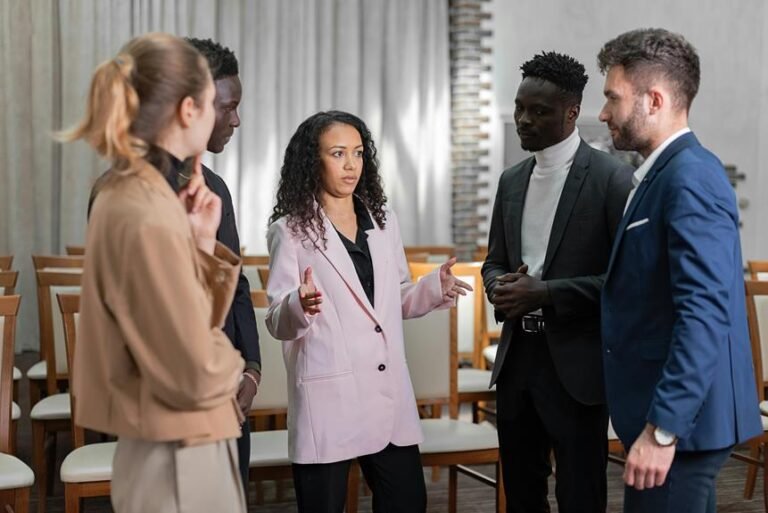Communication Styles: Finding What Works for You

Discovering communication styles that suit you is essential for successful interactions. Pay attention to nonverbal cues like gestures and facial expressions to enhance understanding. Reflect on past interactions to uncover your preferred style — direct or indirect. Adjusting your approach to different situations boosts versatility and connection-building. Embrace your style to foster deeper conversations and stronger relationships. Mastering effective communication is key to maneuvering diverse scenarios with ease and creating impactful connections.
Key Takeaways
- Understand your preferred communication style through self-awareness.
- Reflect on past interactions to identify your tendencies.
- Adapt your style for different situations to enhance versatility.
- Embrace your style to foster deeper connections and meaningful conversations.
- Recognize the importance of adapting to different communication styles for effective interactions.
Understanding Communication Styles
To effectively navigate diverse interactions, understanding different communication styles is essential. Nonverbal cues play a pivotal role in communication, as they can convey emotions and intentions without words. Paying attention to gestures, facial expressions, and body language can help you interpret messages more accurately, especially when verbal communication might be unclear.
Moreover, cultural differences heavily influence communication styles. Different cultures have varying norms regarding personal space, eye contact, and tone of voice. Being aware of these cultural nuances can prevent misunderstandings and foster smoother interactions.
For example, in some cultures, direct eye contact is a sign of respect, while in others, it may be perceived as confrontational.
Identifying Your Preferred Style
Discovering your preferred communication style can significantly enhance your interactions with others. Self-awareness plays a pivotal role in understanding how you communicate with different people. By recognizing your preferred style, whether it's being direct or indirect, you can navigate conversations more effectively. Effective communication stems from aligning your natural tendencies with the needs of those around you.
To identify your preferred communication style, pay attention to how you naturally convey information. Are you more inclined to be straightforward and to the point, or do you prefer to hint at things and let others read between the lines? Reflecting on past interactions can also provide insight into your tendencies.
Being self-aware of your preferred style allows you to adapt your communication approach to suit different situations. Whether you lean towards being assertive or diplomatic, understanding your natural tendencies can help you become a more versatile communicator. Embrace your communication style and use it to foster deeper connections and more meaningful conversations.
Direct Vs. Indirect Communication
Understanding the distinction between direct and indirect communication styles is essential for effective interpersonal interactions. Direct communication involves expressing thoughts and feelings clearly, leaving little room for misinterpretation.
In contrast, indirect communication relies on subtle cues and implications to convey messages, often requiring a deeper level of understanding.
Direct communication is commonly favored in workplace dynamics, where clarity and efficiency are pivotal. On the other hand, indirect communication may be more prevalent in family relationships and social interactions, where maintaining harmony and saving face are prioritized.
Cultural differences play a significant role in shaping these communication styles, with some cultures valuing explicitness while others emphasize implicit cues.
Being mindful of when to use each style can enhance your effectiveness in various contexts. In the workplace, direct communication can prevent misunderstandings and streamline processes, while in family and social settings, indirect communication may foster closer relationships.
Active Listening Techniques
Enhancing your communication skills involves mastering active listening techniques to improve your interactions with others. Reflective listening is a powerful tool in your communication arsenal. It involves paraphrasing and summarizing what the speaker has said to make sure you understand correctly. By reflecting back, you show that you're engaged and genuinely interested in what the other person is saying.
Empathetic communication is another crucial aspect of active listening. Put yourself in the speaker's shoes to understand their emotions and perspective fully. Acknowledge their feelings and validate them to create a supportive environment for open dialogue.
Practice active listening by maintaining eye contact, nodding, and providing verbal cues like 'I see' or 'I understand.' Avoid interrupting and focus on the speaker without thinking about your response while they talk. These techniques not only enhance your understanding but also strengthen relationships by showing respect and empathy towards others.
Adapting to Different Styles
Mastering the ability to adapt to various communication styles is essential for effective interactions with a diverse range of individuals. Flexibility in conversations is key to building strong connections. When engaging with others, pay attention to non-verbal cues and verbal expressions. By being adaptable, you show respect for the other person's preferred style of communication. Navigating mixed signals can be challenging, but staying open-minded and patient is pivotal. Remember, everyone has their unique way of expressing themselves.
To adapt successfully, mirror the other person's communication style subtly. If they're direct and to the point, match that energy. If they prefer a more laid-back approach, adjust accordingly. Flexibility shows that you value the relationship and are willing to meet the other person halfway.
When faced with mixed signals, seek clarification politely. Misunderstandings can arise, but open dialogue can clear the air. By adapting to different styles, you pave the way for smoother and more meaningful interactions.
Utilizing Effective Communication Strategies
To enhance your communication effectiveness, consider employing a variety of strategic approaches tailored to the specific context and individual you're engaging with. Role playing can be a powerful tool to practice different communication scenarios, allowing you to anticipate responses and adjust your approach accordingly. This technique helps build confidence and flexibility in your interactions.
Feedback techniques are also pivotal for effective communication. Encouraging open dialogue and actively listening to others' feedback can enhance mutual understanding and trust. Providing constructive feedback in a respectful manner can promote growth and strengthen relationships.
Frequently Asked Questions
How Can Cultural Backgrounds Influence Communication Styles?
Cultural backgrounds shape communication styles by influencing how you express thoughts, emotions, and ideas. Understanding cultural norms enhances cross-cultural interactions, fostering effective communication. Embrace diversity to navigate different communication styles with empathy and respect.
Is There a Connection Between Personality Types and Communication Styles?
When it comes to communication styles, there is definitely a connection between personality types and how you express yourself. Your unique traits and tendencies can impact how you interact with others, regardless of cultural backgrounds.
Can Technology Impact Our Preferred Communication Style?
In today's world, technological advancements heavily influence how you communicate. Virtual platforms shape your communication preferences and social interactions. Embrace the convenience and flexibility they offer, adapting your style to thrive in a digital age.
Do Age and Generation Play a Role in Communication Preferences?
When it comes to communication preferences, age impacts how you connect. Generational differences shape your style. Embrace understanding diverse ways of communicating to bridge gaps and build strong relationships. Stay open-minded and adaptable.
What Are the Effects of Stress on Communication Styles?
When stress management becomes challenging, communication barriers may arise. Recognize how stress impacts your communication style. Stay mindful of your reactions and emotions. Practice patience and empathy to navigate through tough conversations effectively.
Conclusion
To sum up, understanding your communication style is key to effective interactions. By identifying your preferred style, practicing active listening, and adapting to different styles, you can improve your communication skills.
Remember to be open to new strategies and techniques to enhance your ability to connect with others. Communication is a two-way street, so finding what works for you'll ultimately lead to more successful and meaningful conversations.
Keep practicing and refining your skills to become a better communicator.







4 Comments